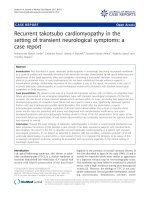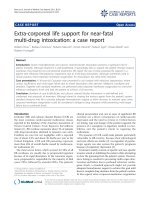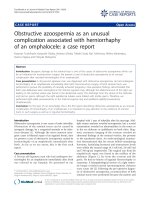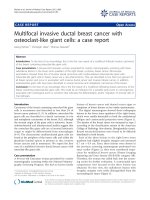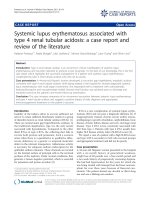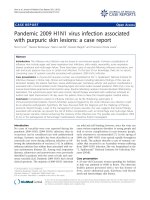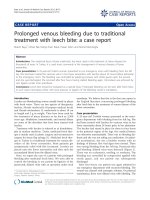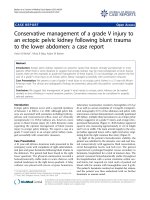Báo cáo y học: " Vaughan-Jackson-like syndrome as an unusual presentation of Kienböck’s disease: a case report" doc
Bạn đang xem bản rút gọn của tài liệu. Xem và tải ngay bản đầy đủ của tài liệu tại đây (2.37 MB, 3 trang )
CAS E REP O R T Open Access
Vaughan-Jackson-like syndrome as an unusual
presentation of Kienböck’s disease: a case report
Tooba Mazhar and Rohit Rambani
*
Abstract
Introduction: Kienböck’s disease is a condition of osteone crosis of the lunate bone in the hand, and most patients
present with a painful and sometimes swollen wrist with a limited range of motion in the affected wrist. Vaughan-
Jackson syndrome is characterized by the disruption of the digital extensor tendons, beginning on the ulnar side
with the extensor digiti minimi and extensor digitorum communis tendon of the small finger. It is most commonly
associated with rheumatoid arthriti s. We describe a case of a patient with an unusual presentation of Kienböck’s
disease with symptoms similar to those of Vaughan-Jackson syndrome.
Case presentation: A 40-year-old man of Indian ethnic origin with no known history of trauma presented to our
clinic with a ten-day history of an inability to extend his right little and ring fingers with associated pain in his right
wrist. He was being treated with long-term steroids but had no other significant medical history. His examination
revealed an inability to extend the metacarpal and phalangeal join ts of the right ring and little fingers with
localized tenderness over the lunate bone. Spontane ous disruption of the extensor tendons was diagnosed
clinically and, after radiological investigation, was confirmed to be secondary to dorsal extrusion of the fragmented
lunate bone. The patient underwent surgical repair of the tendons and had a full recovery afterward.
Conclusion: Kienböck’s disease, though rare, is an important cause of spontaneous extensor tendon rupture. The
original description of Vaughan-Jackson syndrome was of rupture of the extensor tendons of the little and ring
fingers caused by attrition at an arthritic inferior radioulnar joint. We describe a case of a patient with Kienböck’s
disease that first appeared to be a Vaughan-Jackson-like syndrome.
Introduction
Kienböck’s disease is a condition of uncertain etiology
that results in osteonecrosis of the carpal lunate bone.
Patients with this disease present with reports of activ-
ity-related dorsal wrist pain, decreased wrist motion in
the flexion-extension arc, and poor grip strength. The
symptoms tend to occur more often in the dominant
hand.
Vaughan-Jackson syndrome is characterized by the
disruption of the digital extensor tendons, beginning on
the ulnar side with the extensor digiti minimi (EDM)
and extensor digitorum communis (EDC) tendon of the
small finger. If the underlying pathology is not treated,
sequential rupture of the ring, long, and index finger
EDC tendons occurs [1]; ultimately, rupture of the
extensor indicis proprius may follow [2]. Vaughan-
Jackson’ s first report [1] of extensor tendon rupture
described the cases of two elderly laborers with degen-
erative arthritis of the distal radioulnar joint.
Although rheumatoid arthritis is the m ost common
underlying etiology of tendon rupture in the hand and
wrist, abnormalities of the ulnar head resulting from
either traumatic subluxation or Madelung’ s deformity,
bony prominences, and local inflammat ory changes
resulting caused by both Kienböck’s disease and calcium
pyrophosphate dihydrate crystal deposition disease
(pseudogout) have also been described as the cause of
tendon rupture [3-7]. The ulnar side of the wrist is the
most common site of extensor tendon rupture and is
most often due to attritional changes caused by caput
ulnar syndrome. We report an unusual case of a patient
who came to our clinic with Kienböck’s disease present-
ing as a n attrition ruptur e of the extensor tendons to
the ring and little fingers due to dorsal extrusion of the
fragmented lunate.
* Correspondence:
Department of Orthopaedics, Hull & East Yorkshire Hospitals, NHS Trust,
Analaby Road Hull, HU3 2JZ UK
Mazhar and Rambani Journal of Medical Case Reports 2011, 5:325
/>JOURNAL OF MEDICAL
CASE REPORTS
© 2011 Mazhar and Rambani; licensee BioMed Central Ltd. This is an Open Access article distributed under the terms of the Creative
Commons Attribution License (http://creativeco mmons.org/licenses/by/2.0), which permits u nrestricted use, distribution, and
reproduction in any medium, pro vided the original work is properly cite d.
Case report
A 40-year-old man of Indian ethnic origin presented to
our clinic without any history of trauma that he could
recollect, an inability to extend the little and ring fingers
of his right hand, and associated dorsal wrist pain of 10
days’ duration. He had had Cushing’ ssyndromeasa
child and had undergone complete adrenalectomy in his
teenage years. Since then, he had bee n on long-te rm
steroid therapy and said he had no associated complica-
tions. He had no history of any other medical condition.
He was right-hand-dominant and was unemployed at
the time of presentation.
His physical examination revealed that he was unable
to extend the metacarpal and phalangeal joints of his
right ring and little fingers. Also, a small area of nodular
elastic swelling associated with locali zed tenderness over
the lunate bone was present over the dorsum of the
proximal en d of the space between the fourth and fif th
metacarpal bones.
A diagnosis of spontaneous rupt ure of the extensors
to the ring and little fingers was made. Posteroanterior
and lateral radiographs demonstrated Lichtman grade
III Kienböck’s disease with a large, displaced dorsal frag-
ment (Figure 1). Computed tomography with recon-
struction confirmed the clinical diagnosis and
radiological findings (Figure 2).
He underwent surgical exploration through a straight
dorsal incision. Rupture of the three extensor tendons
was i ntimately related to a dorsal fragment of the lunate
bone, which had become extruded through the dorsal
capsule. The dorsal fragment was excised. The indicis
proprius tendon was transferred to the little finger, and
Figure 1 Posteroanterior and lateral radiographs showing that the patient had Lichtman grade III Kienböck’sdiseasewithalarge,
displaced dorsal fragment.
A
B
Figure 2 Computed tomography scan showing reconstruction
confirming the clinical diagnosis and radiological findings.
Mazhar and Rambani Journal of Medical Case Reports 2011, 5:325
/>Page 2 of 3
the ring finger tendon was cable-grafted to the EDC ten-
don of the middle finger. The patient’s post-operative
course was uneventful. He was subsequently treated
with regular hand therapy and ultimately regained full
functionality of his hand and wrist.
Conclusions
Kienböck’s disease, though rare, is an important cause of
spontaneous extensor tendon rupture. Attrition rupture
of tendons is a well-known problem. Finger tendon rup-
ture has been related to various causes, but rare ly has
Kienböck’s disease been implicated [8-11].
Murase et al.[12]andRamkumaret al.[13]reported
extensor tendon rupture and Pacha-Vicente et al.[14]
reported attrition of EDM muscle following long-stand-
ing Kienböck’ s disease, but none of these authors
reported these as the presenting complaints.
The original description of Vaughan-Jackson syn-
drome [1] was of the rupture of extensor tendons of the
little and ring fingers caused by attrition at an arthritic
infer ior ra dioulnar joint. In this case report, we describe
a patient with Kienböck’s disease presenting as
Vaughan-Jackson-likesyndrome.Althoughthesiteof
rupture was found to be directly related to the extruded
fragment’ s causing mechanical attrition rupture, there
may be a correlation between the use of long-term ster-
oids and spontaneous rupture of the extensor tendons
of the hand.
Consent
Written informed consent was obtained from the patient
for publication of this case report and any accompany-
ing images. A copy of the written consent is available
for review by the Editor-in-Chief of this journal.
Authors’ contributions
RR analyzed and interpreted the patient data. TM was a major contributor to
the writing of the manuscript. Both authors read and approved the final
manuscript.
Competing interests
The authors declare that they have no competing interests.
Received: 31 March 2010 Accepted: 25 July 2011
Published: 25 July 2011
References
1. Vaughan-Jackson OJ: Rupture of extensor tendons by attrition at the
inferior radio-ulnar joint: report of two cases. J Bone Joint Surg Br 1948,
30B:528-530.
2. Brooks P: Extensor mechanism ruptures. Orthopedics 2009, 32(9):pii
3. Ducloyer P, Leclercq C, Lisfranc R, Saffar P: Spontaneous ruptures of the
extensor tendons of the fingers in Madelung’s deformity. J Hand Surg
(Br) 1991, 16:329-333.
4. Engkvist O, Lundborg G: Rupture of the extensor pollicis longus tendon
after fracture of the lower end of the radius: a clinical and
microangiographic study. Hand 1979, 11:76-86.
5. Niwa T, Uchiyama S, Yamazaki H, Kasashima T, Tsuchikane A, Kato H: Closed
tendon rupture as a result of Kienböck disease. Scand J Plast Reconstr
Surg Hand Surg 2010, 44:59-63.
6. Gladstone H: Rupture of the extensor digitorum communis tendons
following severely deforming fractures about the wrist. J Bone Joint Surg
Am 1952, 24-A-3:698-700.
7. Inoué G: Attritional rupture of the extensor tendon due to longstanding
Kienböck’s disease. Ann Chir Main Memb Super 1994, 13:135-138.
8. James JI: A case of rupture of flexor tendons secondary to Kienböck’s
disease. J Bone Joint Surg Br 1949, 31B:521-523.
9. Lichtman DM, Degnan GG: Staging and its use in the determination of
treatment modalities for Kienböck’s disease. Hand Clin 1993, 9:409-416.
10. Masada K, Kawabata H, Ono K: Pathological rupture of flexor tendons due
to longstanding Kienböck’s disease. J Hand Surg Am 1987, 12:22-25.
11. Miki T, Yamamuro T, Kotoura Y, Tsuji T, Shimizu K, Itakura H: Rupture of the
extensor tendons of the fingers: report of three unusual cases. J Bone
Joint Surg Am 1986, 68:610-614.
12. Murase T, Ando Y, Hiroshima K: Extensor tendon rupture due to
Kienböck’s disease. J Hand Surg Br 1997, 22:597-598.
13. Ramkumar S, Josty IC, Sykes PJ: Severe extensor tendon attrition and
multiple tendon ruptures resulting from Kienböck’s disease. Ann Plast
Surg 2000, 45:647-650.
14. Pacha-Vicente D, Sevilla-Tirado J, López-Martínez R, Lluch-Bergadà A, Mir-
Bulló X, Llusá-Pérez M: Extensor digiti minimi damage due to
longstanding Kienböck’s disease. J Hand Surg Eur Vol 2007, 32:231.
doi:10.1186/1752-1947-5-325
Cite this article as: Mazhar and Rambani: Vaughan-Jackson-like
syndrome as an unusual presentation of Kienböck’s disease: a case
report. Journal of Medical Case Reports 2011 5:325.
Submit your next manuscript to BioMed Central
and take full advantage of:
• Convenient online submission
• Thorough peer review
• No space constraints or color figure charges
• Immediate publication on acceptance
• Inclusion in PubMed, CAS, Scopus and Google Scholar
• Research which is freely available for redistribution
Submit your manuscript at
www.biomedcentral.com/submit
Mazhar and Rambani Journal of Medical Case Reports 2011, 5:325
/>Page 3 of 3

